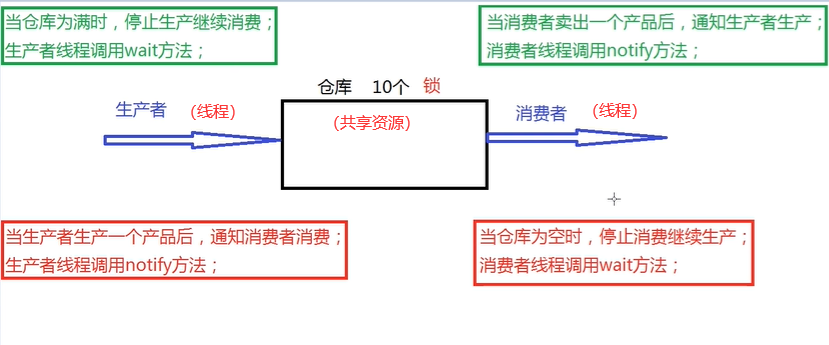1. 图解

2. 代码示例
<1> 仓库类
1 public class StoreHouse { 2 private int cnt = 0; // 用于记录产品的数量 3 4 public synchronized void produceProduct() { 5 notify(); 6 if (cnt < 10) { 7 System.out.println("线程" + Thread.currentThread().getName() + "正在生产第" + (cnt+1) + "个产品..."); 8 cnt++; 9 } else { 10 try { 11 wait(); 12 } catch (InterruptedException e) { 13 e.printStackTrace(); 14 } 15 } 16 } 17 18 public synchronized void consumerProduct() { 19 notify(); 20 if (cnt > 0) { 21 System.out.println("线程" + Thread.currentThread().getName() + "消费第" + cnt + "个产品"); 22 cnt--; 23 } else { 24 try { 25 wait(); 26 } catch (InterruptedException e) { 27 e.printStackTrace(); 28 } 29 } 30 } 31 }
<2> 生产者线程
3 /** 4 * 编程实现生产者线程,不断地生产产品 5 */ 6 public class ProduceThread extends Thread { 7 // 声明一个仓库类型的引用作为成员变量,是为了能调用调用仓库类中的生产方法 合成复用原则 8 private StoreHouse storeHouse; 9 // 为了确保两个线程共用同一个仓库 10 public ProduceThread(StoreHouse storeHouse) { 11 this.storeHouse = storeHouse; 12 } 13 14 @Override 15 public void run() { 16 while (true) { 17 storeHouse.produceProduct(); 18 try { 19 Thread.sleep(1000); 20 } catch (InterruptedException e) { 21 e.printStackTrace(); 22 } 23 } 24 } 25 }
<3> 消费者线程
1 public class ConsumerThread extends Thread { 2 // 声明一个仓库类型的引用作为成员变量,是为了能调用调用仓库类中的生产方法 合成复用原则 3 private StoreHouse storeHouse; 4 // 为了确保两个线程共用同一个仓库 5 public ConsumerThread(StoreHouse storeHouse) { 6 this.storeHouse = storeHouse; 7 } 8 9 @Override 10 public void run() { 11 while (true) { 12 storeHouse.consumerProduct(); 13 try { 14 Thread.sleep(100); 15 } catch (InterruptedException e) { 16 e.printStackTrace(); 17 } 18 } 19 } 20 }
<4> StoreHouseTest.java
public class StoreHouseTest { public static void main(String[] args) { // 创建仓库类的对象 StoreHouse storeHouse = new StoreHouse(); // 创建线程类对象并启动 ProduceThread t1 = new ProduceThread(storeHouse); ConsumerThread t2 = new ConsumerThread(storeHouse); t1.start(); t2.start(); } }